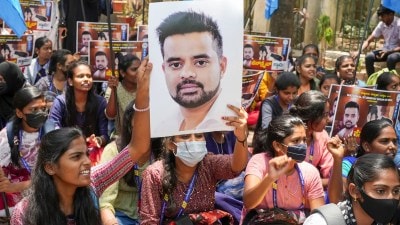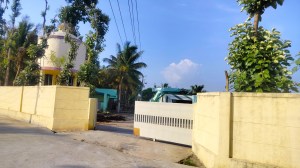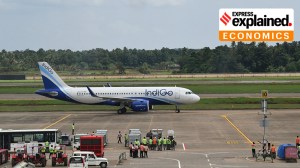- India
- International
Battered icon: The story of the Kalka-Shimla Railway, which has been devastated by the landslides in Himachal Pradesh
The more than 120-year-old railway, passing through difficult mountainous terrain, has perhaps never been damaged to this extent earlier. How did this thing of great beauty and awesome architectural prowess, a UNESCO World Heritage Site, come to be built?
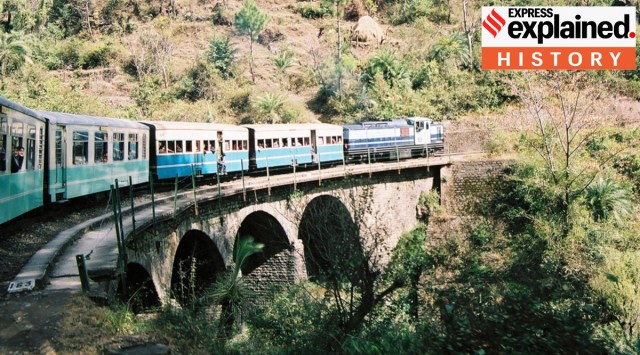 The Kalka-Shimla Railway passes through 18 stations, 102 tunnels, and over 988 bridges. It offers majestic views for most of the route. Passengers see breathtaking valleys, covered with pine, oak, and deodar trees. (Photo: Wikimedia Commons)
The Kalka-Shimla Railway passes through 18 stations, 102 tunnels, and over 988 bridges. It offers majestic views for most of the route. Passengers see breathtaking valleys, covered with pine, oak, and deodar trees. (Photo: Wikimedia Commons) The more than 120-year-old Kalka-Shimla Railway (KSR) has sustained severe damage due to the heavy rainfall in Himachal Pradesh, and the section between the Jutogh and Summer Hill stations, just before Shimla, has been washed away.
This is the second major blow to the iconic railway in this monsoon of exceptionally heavy rainfall in Himachal. On July 8, piles of mud, boulders, and trees fell on the tracks at 135 places — a consequence, Railway officials claimed, of the “unscientific” laying of drainage pipes under the Kalka-Shimla national highway.
The railway had been shut down and a tender for repairs had been floated at the time; after the catastrophic 55-hour downpour over the weekend, the timeline for the resumption of services is now uncertain.
The beloved scenic railway, which was declared a UNESCO World Heritage Site on July 8, 2008, offers picturesque views of lush green trees and valleys as it winds its way up from Kalka, at an elevation of 2,152 ft above sea level in Haryana, to the capital of Himachal Pradesh, at 6,808 ft.
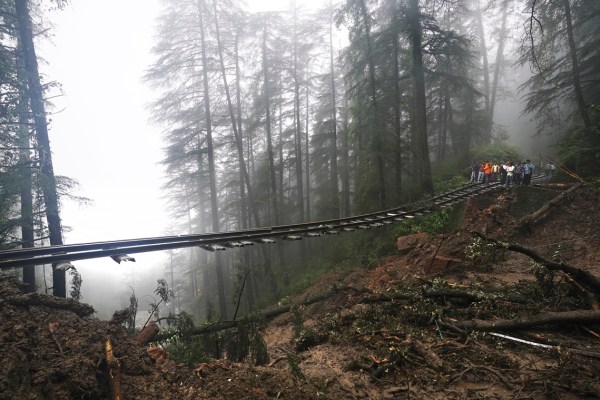 A portion of the Shimla-Kalka heritage railway track that got washed away following heavy rainfall on the outskirts of Shimla, Himachal Pradesh state, on August 14, 2023. (AP Photo/ Pradeep Kumar)
A portion of the Shimla-Kalka heritage railway track that got washed away following heavy rainfall on the outskirts of Shimla, Himachal Pradesh state, on August 14, 2023. (AP Photo/ Pradeep Kumar)
The narrow gauge “toy train” passes through 18 stations, 102 tunnels, and over 988 bridges. It offers majestic views for most of the route. Passengers see breathtaking valleys, covered with pine, oak, and deodar trees.

This is the story of India’s railway of pride, beauty, romance, and history.
There is a reason the British built the Kalka-Shimla railway.
The British began to establish the hill station, then spelt ‘Simla’, in 1830 after buying land from the Maharaja of Patiala and the Rana of Keonthal. The Europeans, who were looking for a summer escape from the sapping heat and humidity of their capital Calcutta and elsewhere in the Gangetic plains since at least the early 1800s, had established their first lodging in the area, which was less damp than Darjeeling in the east, in 1819, according to a paper by Saumya Sharma of the Chandigarh College of Architecture. (‘Shimla: A Case Study of Transition from a Colonial Capital to an Indian Town’: Traditional Dwellings and Settlements Review, 2020)
“As the town (Shimla) grew, it increasingly came to be visited by members of the British imperial bureaucracy. And by the 1840s, it began to take the shape of a proper settlement, with public buildings, residences, amenities, commercial streets, and gathering spaces,” Sharma wrote.
In 1864, the British declared Shimla as the imperial summer capital of India. The viceroy and his council would move office from Calcutta to the hill station for seven months every year, from April to October. This was a daunting task, and the 1,600-km journey by horse, elephant, bullock cart, and sedan chair (paalki) took weeks of preparation and travel.
The railway was conceived of early, but it was several decades before it was commissioned.
The November 1847 issue of the Delhi gazette sketched out the route of the railway, and several surveys were carried out in the years that followed. But the proposal got a boost only after the railway line from Delhi to Kalka via Ambala was built, noted the 2021 book, ‘Hill Railways of the Indian Subcontinent’, by Richard Wallace.
Approval to build the KSR finally came after a project report based on two surveys that were carried out in 1884 and 1885, was submitted to the Indian government in 1887. Two years later, on June 29, 1889, the Delhi-Umballa- (now Ambala) Kalka Railway Company signed an agreement with the secretary of the state to build the railway.
“As per the contract, the rail line was to be built without any pecuniary aid or guarantee from the government. The land was, however, provided free of charge to the company. The estimated cost of Rs 86,78,500, doubled during execution of the project,” R Priya of Ethiraj College for Women, Chennai, wrote in her PhD thesis ‘The Development of Mountain Railways in India: A Study’, completed in 2016.
The project became more ambitious as it progressed, but it still required the blessings of a local holy man.
Initially, the KSR was planned as a 2-foot narrow-gauge railway. The narrow gauge is a railway in which the distance between the two rails, known as the track gauge, is usually between 1 foot 11 inches and 3 feet 6 inches. In the standard-gauge railway, the track gauge is about 4 feet 8 inches. Narrow-gauge lines allow trains to make tighter turns in valleys and difficult terrain.
“However, in 1901, before completion, it was decided to convert the line to the wider 2 ft 6 in gauge; this was due to a decision by the military in 1898 that all light or narrow-gauge railways deemed likely to be used for ‘British Empire military purposes’ should be built to this gauge. This was for reasons of standardisation and to permit easy interchange of rolling stock to meet possible extra requirements for lines in strategic areas,” Wallace wrote.
Government records note the contribution of Baba Bhalku, a local holy man, who played a crucial role in the construction of the KSR. It is said that the saint used his stick to make measurements that helped the British engineers who were unfamiliar with the terrain, to lay the track. To commemorate Baba Bhalku’s contribution, the government named a museum after him in Shimla, which preserves the rich heritage of the KSR, in 2011.
The line was opened for traffic on November 9, 1903.
The line was initially 95.68 km from Kalka to Shimla. To allow for the transport of freight, the line was subsequently extended from Shimla station to what was then known as the Old Bullock Train Office (now called Shimla Goods), just below the main bazaar — making the KSR 96.6 km long.
This is much longer than most other narrow-gauge railway lines in the world. “They (the other railways) are roughly ten kilometres long, whereas the KSR is around 100 km long, with a total level difference of around 1,500 m,” a 2008 report by the Paris-based International Council on Monuments and Sites (ICOMOS) said.
The first steam locomotives to run on the line were manufactured by the British Sharp Stewart and Company in 1901 and 1902. Rail motor cars were introduced in the 1910s, and were considered the epitome of luxury. The earliest versions of these petrol locomotives were supplied by another British manufacturer, Drewery Car Company. In 1955, German-made diesel locomotives were procured.
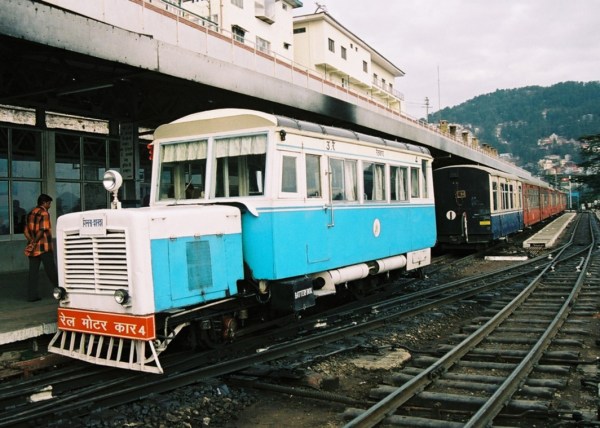 One of the Rail Motor Cars at Shimla Station ready to leave for Kalka on February 13, 2005. (Photo: Wikimedia Commons)
One of the Rail Motor Cars at Shimla Station ready to leave for Kalka on February 13, 2005. (Photo: Wikimedia Commons)
Soon after the line’s inauguration, the DUKR ran into financial troubles due to the high maintenance cost of the KSR, and was bought over by the British government in 1906. “Kalka Shimla Railway was managed as an independent unit from the NWR (North Western State Railway) office Lahore till 1926. Later on the management of Kalka-Shimla line was transferred to Delhi Division. Since July 1987, this is being managed from Ambala Cantt,” says an official government document.
Seven different trains run on the KSR network every day, according to IRCTC’s Rail Yatri website.
While trains like the Shivalik Deluxe Express, a luxury toy train that features carpeting, large glass windows, and comfortable cushioned seats, and the Rail Motor Car, a single-coach train, make it to Shimla from Kalka in about four hours, the Himalayan Queen, a toy train with first- and second-class coaches, take more than five hours to complete the journey.
 The Kalka-Shimla Railway route. (Photo: Himachal Services)
The Kalka-Shimla Railway route. (Photo: Himachal Services)
Before the current disaster, the Railways were set to introduce indigenously manufactured Vistadome coaches with glass roofs similar to Swiss scenic railway carriages for the KSR.
There are many multi-arch viaducts (long bridge-like structures) and tunnels along the route of the KSR. There are 919 curves on the route, and the train turns 48 degrees at the sharpest of them. The longest tunnel is the Barog Tunnel (number 33) between the Dagshai and Solan stations, which is more than a kilometre long.
“The most architecturally complex bridge is bridge number 226 which spans a deep valley that is enclosed on two sides by steep peaks. This bridge was constructed in five stages with each level having its own stone arched tier,” Priya wrote in her paper.
The KSR has stood the test of time. But it faces perhaps its gravest challenge now.
Damage to the KSR isn’t new. In 1978 and 2007, the line was severely damaged due to landslides. The 2007 mishap was more intense as heavy rainfall washed away part of the Koti station building. Each time, however, services resumed within days.
“The property is one of the best preserved mountain railways in India, and remains much as it was at the time of its completion. In addition to its engineering infrastructure, it has retained its stations, signalling system and a rural environment and landscape that are virtually unchanged,” the ICOMOS report noted.
But the current damage poses a very formidable challenge.
In July, after the first round of landslides forced Northern Railway to shut down KSR until August 6, Ambala Divisional Railway Manager Sandeep Singh Bhatia had told The Indian Express: “It is the first time that these tracks will be out of action for so long. Never in its history have they got damaged to this extent.”
Sanjay Kaushal, who walked the entire 96.6 km stretch of the railway for a coffee table book (‘From Earth to Sky: A Journey on the Kalka-Shimla Railway’) published in 2015, had told The Indian Express: “It is not just the damage that is disturbing us; it is the extent of the damage that is alarming. In August 2017, a cloudburst washed away the tracks along with a significant portion of Koti railway station. While the Kalka-Shimla stretch does face landslides and tree falls, especially during the monsoon, train services typically resume within 72 hours under normal conditions.”
More Explained
EXPRESS OPINION
May 06: Latest News
- 01
- 02
- 03
- 04
- 05











